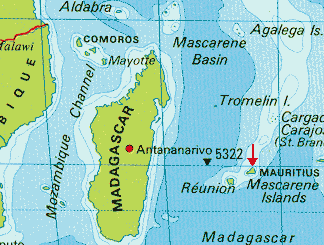 |
| Port Louis, the capital of Mauritius. |
Traveling with our 8-month-old son, we opted for studios equipped with kitchenettes, which allowed me to indulge in the ultimate foodie pleasure: exploring the local markets. While perusing the aisles in search of a little extra something to complement our humble turkey sandwiches, I grabbed a jar that I instantly recognized as being a local, heretofore undiscovered harissa. The name on the label alone, “Mme Yolanda Begue’s Ile Rodrigues Mazavaroo” underlined its exotic origin (Ile Rodrigues is an island 600 kilometers off the coast of Mauritius.
I grabbed two jars—a red one and a green one—and hurriedly made my way to the beach to slap together our next meal. The first bite of our sandwiches delivered the perfect harissa. It actually tasted good, unlike many other harissas on the market that focused merely on their spice index. It was just salty enough, and the taste was mitigated by a sweetness plus a hard-to-place smokiness. In spite of the smokiness, the paste had a fresh taste, perhaps owed to fresh ingredients and the simplicity of the concoction. The consistency was smooth, almost creamy, dotted with specks of seeds. In that first bite, I tasted the sugar cane, the Creole heartbeat, the years of slavery that built the island.
My husband and I looked at each other; though we were already pretty buzzed by the environment, the sun and the water, the Mazavaroo swept us up to that place where the angels sing. It was the perfect harissa high. There was the familiar tingle at the top of the nose and just a slight compression at the crown of the head. There was no crash at the end but an exhilarating afterglow. Once the spice buzz passed, it left the island taste in my mouth, a pleasant reminder of the experience. Mazavaroo eclipsed any other harissa I’d ever had.
Back in Zurich, I was worried that perhaps our first experience with Mazavaroo would never be matched by subsequent ones, as is the case with most intoxicants. But Mazavaroo did not disappoint us. There are many versions of Mazavaroo, and I unfortunately only had the opportunity to try one. The jar I had listed only four ingredients: chilies, garlic, oil and vinegar. I scoured the internet for information on the “maz” and found little; of course I wanted to replicate it, but the recipes I found made no mention of the actual chili pepper used. Was it dried before hand, as it was in a proper Tunisian harissa? Were the peppers smoked?
Some of the recipes I encountered listed raisins as an ingredient, an addition that left me puzzled. A family friend who is a French chef and familiar with Mauritian cuisine thoughtfully asserted that Mazavaroo must have a fish component—a prawn or fish paste of some sort. Mazavaroo remains something of a mystery and it’s one of many good reasons to go to the island. I can easily imagine many of my fellow spice enthusiasts having the same starry, eye-popping experience with this stuff. Thank goodness for Ms. Yolanda Begue.
Mazavaroo
This recipe was given to me by Virjanan Jeenea, the sous-chef at the Oberoi Hotel in Mauritius. I was happy to see that his recipe is simple compared to others I have run into. I tried it four different ways: with fresh bird’s eye peppers and again with fresh Thai dragon peppers, then adding shrimp paste to one and ginger to the other. The best result I obtained was by following the Oberoi recipe with the bird’s eye peppers, although it still lacks that smoky fantasia found in the jar I initially bought. Below is the Oberoi’s adapted version.
1/2 cup fresh red chillies (preferably pili-pili or bird’s eye peppers)
1/3 cup vegetable oil
1 teaspoon garlic, sliced
1/2 teaspoon salt
1 lemon, peeled
Pre-heat pan and add oil. Add the garlic and chilli peppers. Sautee on moderate heat for 15 minutes, being careful not to burn the garlic. Remove from heat. Mix the garlic and peppers with salt and the lemon in a mixer.
Salata Mechouia Nablia
3 large red bell peppers
1 large fresh red chile, such as New Mexican (or more, to taste)
2−4 garlic cloves, unpeeled
3 large tomatoes
1 teaspoon caraway seeds
2−3 tablespoons olive oil
Salt to taste
Quarters of hard boiled eggs, chunks of canned tuna fish and
black olives to serve
Preheat the broiler or grill and place the peppers, chili, garlic and tomatoes in a broiler pan and cook, turning occasionally until the skins are charred and blistered, and the garlic is soft. Leave to cool then peel the vegetables. Discard the cores and seeds from the peppers and chili, and the seeds from the tomatoes.
Put all the vegetables into a blender or food processor. In a frying pan, gently heat the caraway seeds and oil until fragrant.
Add to the blender or food processor with the salt and puree to a paste. Chill before serving. Serve in a bowl with quarters of hard boiled eggs, chunks of tuna fish and black olives.
Yield: 4 servings
Heat Scale: Mild to Medium
*For another condiment recipe similar to harissa, read the article “Blessed to be in Bhutan.”





